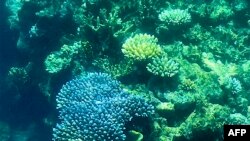For the fourth time in seven years, the authority that administers one of Australia’s greatest natural treasures has reported widespread bleaching on the Great Barrier Reef.
This occurs when the sea is too warm for too long. It forces the coral to expel microscopic symbiotic algae that gives it most of its energy and color.
Reefs can recover from bleaching, but it can take years. If water temperatures don't return to normal, the coral can die. Large parts of the reef were killed off by mass bleaching in 2016 and 2017.
Officials say it’s happening again. They are hoping it won’t be as destructive as previous years, but serious threats remain.
David Wachenfeld, who is the chief scientist with the Great Barrier Reef Marine Park Authority, said reefs all over the world are under pressure.
“Often the Great Barrier Reef is used as a poster child for the impacts of climate change on coral reefs," he said. "And I completely understand that, but climate change is a global problem. It needs a global solution, and it is all of the world’s coral reefs that are under threat."
The United Nations is assessing the impact of global warming on the Great Barrier Reef, as well as localized threats, including pollution and over-fishing.
In Canberra, the government has insisted it’s the “best-managed reef in the world” and that multi-million-dollar programs are boosting its resilience.
Conservationists argue, however, that Australia needs far more ambitious plans to curb its carbon emissions.
The Australian Marine Conservation Society (AMCS) said Wednesday that during a La Nina event, which is a naturally occurring weather cycle, eastern Australia receives more cloud cover and rain that should have “been a welcome reprieve for our Reef” from warmer ocean temperatures.
However, an AMCS spokesperson warned that bleaching was “becoming more and more frequent” and that this was “not normal.”
The Great Barrier Reef runs 2,300 kilometers down Australia’s northeastern coast and spans an area about the size of Japan.









